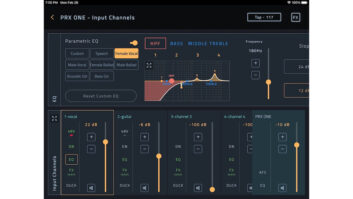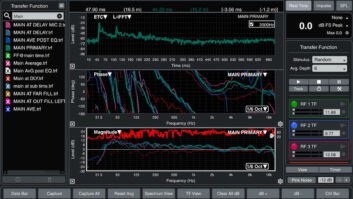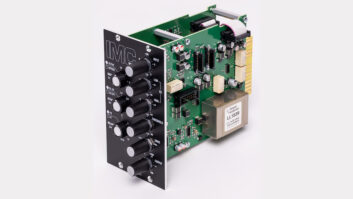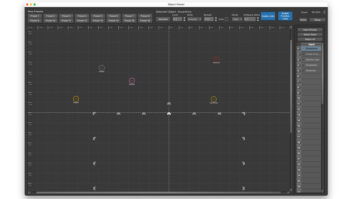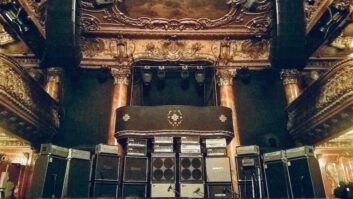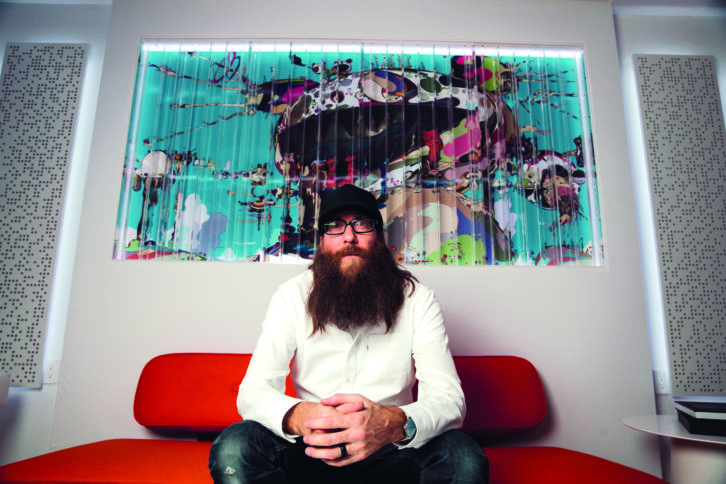
Crowder seems to be having fun right now. He just delivered his fourth solo record, Milk & Honey, to sixsteps/Sparrow Records. His never-ending tour schedule is picking up again, with larger crowds returning and more stops along the highway. And for the past year, he has been making music—writing, recording and collaborating—in his first real studio since leaving Waco, Texas, and going solo eight years ago.
“I’ll be turning in the masters on Friday,” Crowder says from the studio in mid-April, before cutting a few vocal passes later in the day. “I’m at the very end of it, so this week is kind of putting the period at the end of the sentence. I love this time. It’s so high-stress, and I thrive on that. The arrow is about to be off the string, now let’s get it done.”
Milk & Honey just may be Crowder’s best record yet, reflecting a maturity in the songwriting and a deep and varied mix of musical influences, from country to electronic, bluegrass to rock, with a bit of hip hop adding to the rhythms and filling out the low end. A lot of that has to do with the fact that he’s had time to soak up the culture and finally feel at home in Atlanta.
But it also has to do with the fact that for the past eight years, he had done three records on the road—in the backs of buses, in hotel rooms, at studios in towns the bus was passing through, with big chunks of recording in Nashville when time allowed. A lot of work was done on headphones, he says, “where you could sometimes hear the buzz of the generators on the recording and the wheels rolling underneath you.”
For Milk & Honey, however, Crowder created 90 percent of the record in the studio pictured on this month’s cover, in the basement of his home, within a true monitoring environment and a Dante network scheme that allows him to pull up any guitar, synth, amp, keyboard, microphone, plug-in, workstation, drum or stringed instrument with essentially one click and begin recording.
“I’m beyond thrilled with how the studio, the whole thing, turned out,” Crowder says. “We started working on it in October 2019, and then in March 2020, on the weekend that everything shut down and we had to come home, they were putting in diffusors and finishing up the lighting. They wrapped everything up just in time for me to have this incredible space. I basically lived down here in 2020. It’s been home.”
THE WHOLE-HOME STUDIO
Only a true musician and recording geek would spend a pandemic year in the basement with a home like Crowder’s just a floor above. It’s a space designed to inspire, filled with the owners’ unique taste in modern art and reflecting the clean lines and light favored by his wife, interior architect Toni Crowder.
She knocked out the walls and transformed the flow, the look and the feel of the entire space, from the minute you walk in and are greeted in the foyer by Patsy, an 8-foot, bright pink sculpture. Down in the basement, there is artwork behind the back wall diffusor and multicolored skateboards (Crowder’s own) over the DJ Booth. Every room of the house, even the spacious outdoor patio by the pool, is wired with Cat6 and can feed the studio downstairs. Likewise, Crowder can project Pro Tools screens and play back high-resolution audio anywhere he likes. Already he has recorded group vocals in the living room, with its 25-foot vaulted ceiling. A guitar-amp room has been set up, offering him up to six different amp-and-mic combinations at any time. When a guest visits, they can plug in their own rig within minutes and join Crowder for a writing or recording session in the studio.
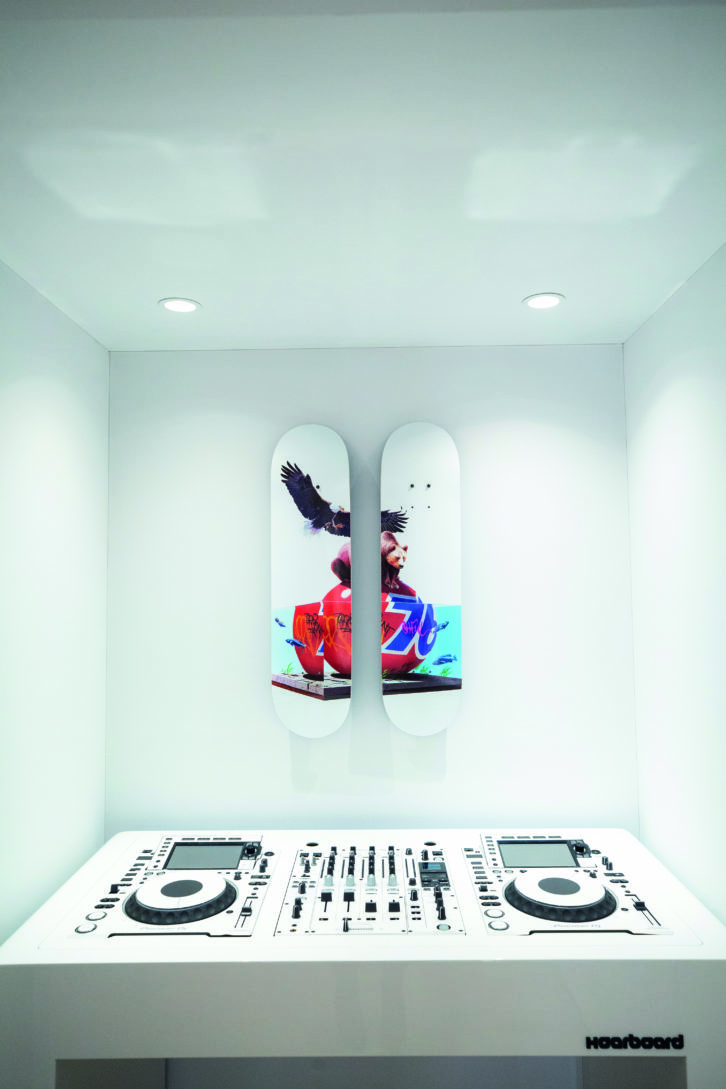
“Artists shouldn’t have to be worrying about what input they need to be on or what particular instrument needs a patch—that takes away from their creativity,” says Jacob “Biz” Morris, who, besides designing and integrating the audio network and equipment installation, is chief engineer for the four studios at Atlanta-based record label Reach Records and a Grammy-winning engineer in his own right. (Note: Morris mixed Milk & Honey for Crowder at Reach Records studios.)
“In David’s case, I knew that he wanted to have 20-some synths and keyboards on hand,” he continues. “He has guitars, banjos, amps, microphones, and they all need to be turned on at all times and just come up as an input on Pro Tools. That was a huge challenge. I didn’t want to run 60 cables from the back corner where he has his keyboard and synth racks—that would have been crazy inside the wall. So we went Dante, and TASCAM was a huge lifesaver. That room wouldn’t be what it is without those TASCAM converters. They can do 32 channels of audio through one CAT-6 going back and forth. There was a lot of complex programming, but still, it’s amazing what you can now do to make a true hybrid analog-digital studio where you never really have to leave the mix position.”
“Getting to make this album in this space, where everything’s just on and functional, was just fantastic,” Crowder adds. “It’s not even plug-and-play; it’s just ‘go play something!’ And with the templates we’ve got set up and the way things are routed, from the guitar amp rooms to all the synths, there’s no hiccup or bump in the creative space. It’s just all flow. I can’t even describe how much fun that is.”
IT WASN’T ALWAYS SO EASY
This isn’t Crowder’s first studio, though it’s his first to be professionally designed and acoustically true. It’s also not the first time that he and Toni have taken a rundown property and turned it into a showplace of art, architecture and inspiration, with a musical backbeat.
While in Waco, after attending Baylor in the late 1990s and launching his music career out of the University Baptist Church, which he co-founded with other students, he and Toni bought a rundown, downtown property once owned by the man who invented Dr Pepper.
“We got it real cheap and it was really rundown,” Crowder recalls. “But in the back of the house there was a barn, and the locals say that was where they kept Pepper the horse. This is right downtown. We started remodeling. We turned the barn into a studio and cut all but the first two albums that I made with what was known as the David Crowder Band. That was basically just the church band. We did all those in the in the studio behind the house. It had a nice, rustic feel, with an spacious, A-framed drum loft upstairs, really a great space. When we moved out of Waco, that was the hardest thing to say goodbye to because that’s where I was making music.”
Then, a year after moving to Atlanta, he and Toni purchased a home that was voted “ugliest house in Atlanta” by Curbed, a local real estate magazine, a space that Crowder describes as “what you might imagine if Scarface and Miami Vice had a house baby.” Toni worked her magic, transformed the property, and by October 2019 work started on the studio, the last open space left.
This time, however, Crowder reached out to professionals, first Morris, whom he had come to know through mutual friends and events in and around the Atlanta music community. The first thing Morris said back to him was, “Cool. I’d like to work with Gavin on this. You’ll like him. He’s the best acoustics guy out there.”
Gavin is Gavin Haverstick, studio designer and founder of Haverstick Designs in Carmel, Ind. He and Morris had worked together on a couple of studios, including Tori Kelly’s in Los Angeles and a church design/install in Atlanta. Morris asked him down to Atlanta to take a look at Crowder’s empty basement space, next to the home theater and down the hall from the entertainment room, not far from Toni’s design office.
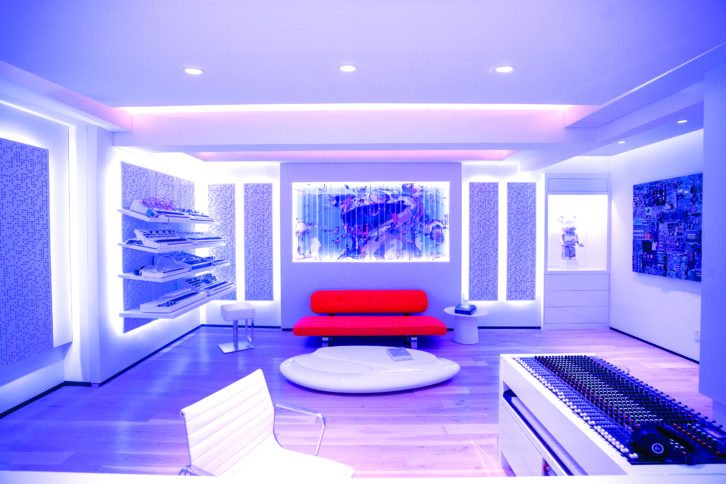
MAKING IT SOUND GOOD
“Their entire house is amazing, and when we first stepped in the foyer, I knew that the studio would need to match the rest of the house in some way,” Haverstick recalls. “Obviously, I want any of my rooms to be acoustically solid, but I also want them to be visually striking and be something that’s inspiring to that particular artist. Really, it was me, Biz and Toni just figuring it out, from the cabling in the walls to the artwork behind the back-wall diffusor, which is a real focal feature of the room.
“And then Crowder and Toni threw me a curveball right at the beginning of the process when they said, ‘We want it to be completely white,’” he adds with a laugh. “At first I was a little disappointed, honestly, because the rest of the house has a lot of modern, clean lines, pieces of pop art in different areas and some vibrant colors throughout. I thought we could have had a lot of fun with that. But they were right, going with the white color theme allows us to use LED elements in the room to turn it completely pink or blue or green or whatever you want to set the mood for the day, or that one song.“
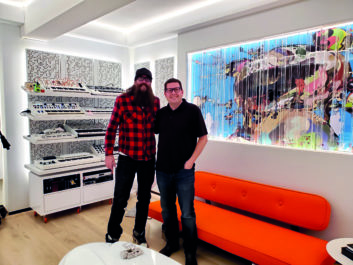
From the start, Haverstick knew that while it was still important, sound isolation wasn’t the number one priority—flexibility, design and a premium listening space were. On that initial visit, he took measurements, figured out the best way to lay out the room and then returned home to create a first series of renderings
“It was a nice, big space for a basement, with good ceiling height,” Haverstick says. “His main goal was to have a professional, creative space that he could write and record in. Since sound isolation wasn’t the main priority, it was honestly kind of refreshing. So much time and money can be spent on isolating rooms when that might not be what the artist needs the most. For Crowder’s studio, it was all the fun stuff.”
As he has on many projects, Haverstick worked with Simplified Acoustics out of West Lafayette, Ind., on all the white stretch fabrics and the installation of the acoustic treatments. The company made use of rare 126-inch-wide white acoustical fabric, allowing for roughly 10 feet between breaks. Haverstick says that even if you look closely, you can’t see the seams.
Behind the fabrics, there’s a lot of formaldehyde-free Fiberglas packed around a series of custom-made perforated panels built by Buildhouse to absorb low frequencies and scatter the mids and highs. A couple panels sit on top of the fabric along the back wall, to the left and right of the clear Plexiglas diffusor, that appear slightly recessed into the 8-inch bass trap behind the wall.
“That’s so we get the axial mode control from front to back in the room, while also getting the diffusion from the mids and highs that we want,” Haverstick explains. “Then there’s soffit traps around the perimeter between the wall and the ceiling junction to help with tangential modes.
“The cloud above the mix position is also a really nice feature,” he continues. “It’s angled, and it is actually physically attached to that front wall, then it cantilevers out over the desk. We had to get the angle right to get as much clear height as possible. It’s pretty much all absorption, to help with first reflections near the mix position.”
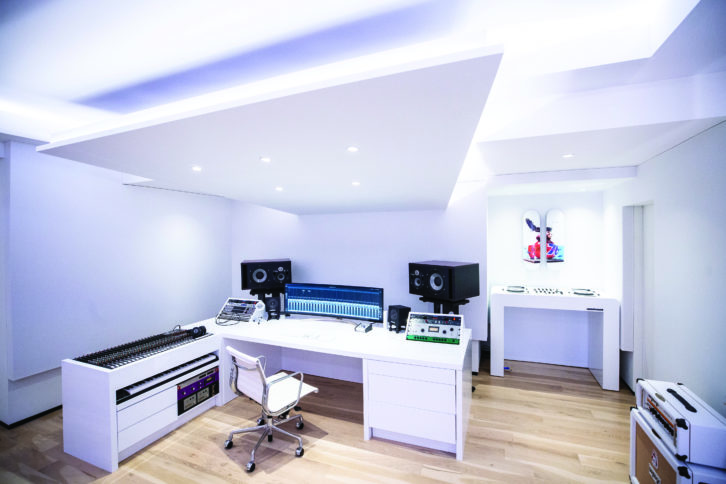
HAPPY AT HOME
Crowder works almost entirely in the box, rotating in keyboard and MIDI controllers and working mostly in Pro Tools, Logic and Ableton. His main monitors are a pair of Focal Trio 11s, which he later had painted custom white. It’s what makes him feel comfortable. Inspiration can come from everywhere.
“I’ve never really had a great listening environment,” Crowder says. “Now here we are at the end of this album, and I’m checking out the mixes that are being sent back, checking out the mastering. Just to have this acoustically true room is amazing. I’m now in a space where I know what I’m getting. I know what it’s going to sound like when I get in the car because I know what it sounds like down here. That part of it has been a blast., I’m not having to second guess myself anymore!”
